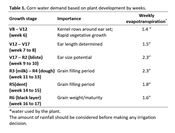|
Why Irrigation?
DR. AVAT SHEKOOFA
JACKSON, TENN.
Knowing when and how much to irrigate a crop is determined primarily by four factors – availability of the water in the soil, water needs of the crop, value of any rainfall and actual output of the irrigation system.
The Mid-South region of the U.S. receives sufficient annual rainfall to grow corn without irrigation in most years, but irrigation is common for corn because rainfall is not always distributed adequately and timely for the crop. Therefore, not all rainfall can be considered effective.
Overall, corn requires different amounts of water at varying growth stages. It requires less water at the early (seedling to V8) and late (R6) growth stages (Table 1), while the peak water requirement occurs during the period two weeks before and after silking.
Soil water sensors are one tool that can be utilized to better assess soil water content in the soil profile and schedule an irrigation appropriately.
Irrigation in subhumid areas
The high frequency and probability of rainfall makes irrigation scheduling in subhumid areas such as West-TN difficult. Therefore, for proper irrigation and to avoid damage from water stress as well as overwatering corn we should install soil moisture sensors in our fields.
What depth is better for installing soil water sensors?
The active root zone of the crop determines the depth at which to place the soil water sensors. Type of crop, soil depth and growth stage largely determine the active root zone. The range to consider is, 6 to 36 inches. In most cases two depths will be considered for soil water sensors installation. But, the sensors can be installed in multiple depths such as 6, 12, 24, and 36”.
When to install the sensors?
The sensors can be installed as soon as corn stand is established. Once corn plants reach to V2-V5 the sensors should be carefully located in the row using soil probe or auger (Fig. 1). One thing to remember while installing sensors and the station is to select representative areas of the whole field for installing them.
When to start irrigation?
In order to manage an irrigation system effectively and schedule irrigation for corn during high water-use periods, we need to know when to start irrigation. Various soil textures need different irrigation scheduling. Other factors, such as irrigation capacity and type as well as crop growth stage may change the soil moisture level for scheduling irrigation.
Soil water sensors designed by Meter Inc.® and WatermarkTM are able to measure soil water potential and water holding capacity (i.e., soil water tension) based on cb (kPa). The interpretation of range 65-70 cb (kPa) while reading these sensors is stress range for most soil and crops including corn. Therefore, how to evaluate the sensor values throughout the rooting zoon is very important for proper irrigation scheduling.
If soil water sensors are installed at different depths/root zones we should expect to see different values throughout the soil depth. Also, the sensor reading values will fluctuate day by day due to plant growth and plant root utilizing water from varying depths.
Here is an example based on our sensors in a corn field in Milan REC during the second week of June 2020 to help you to understand the importance of the soil water sensor readings. In this example, the rooting zone consists of the top 26 inches (100 percent) of the soil profile with one sensor at 8” (30 percent) and one at 26” (70 percent). Table 2., is presenting the calculation of irrigation initiation:
Assuming, the range 65-70 cb (kPa) is stress range for our silt loam soil and our corn crop then, 23 kPa is not even close to an initiation trigger of 65 or 70 kPa. Therefore, there is no need to initiate irrigation at this time. For more examples please see: https://www.mississippi-crops.com/2 016/05/24/utilizing-moisture -sensors-to-increas e-irrigation-efficiency/
Previous irrigation studies recommend using an initiation trigger point approximately 20 cb (kPa) lower than the above values (i.e., 65 or 70 kPa) for older center pivots with limited capacity, compared to other irrigation systems.
Meanwhile, keeping a record of rainfall data along with the sensor reading values will help to better evaluate soil water conditions and trigger irrigation at the right time. ∆
DR. AVAT SHEKOOFA: Assistant Professor, Crop Physiologist – Water Stress & Irrigation, University of Tennessee



|
|